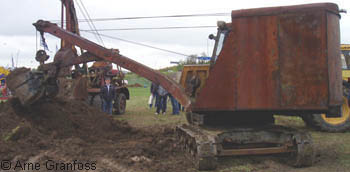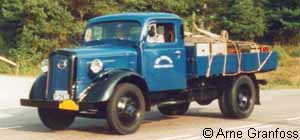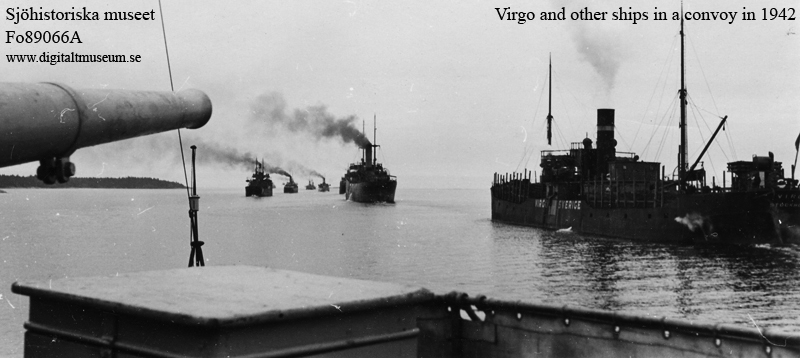Swedish trade with Germany

 UNDER CONSTRUCTION Version 0.41
UNDER CONSTRUCTION Version 0.41
|
Sweden in World War II - across borders
|
 |
![]()
![]()
![]()
Around 1936 Germany was in a period of protectionistic politics, and one part was to rather use its own resources than to import. Among others they constructed new smelting
plants prior to import better iron ore from Sweden. [s08]
![]()
In 1937 a new public authority was formed in Sweden, to produce maps. Earlier the minitary had that task. The first order was to produce a photographic map over Sweden. In need of expertice and equipment, they contacted Germany and were provided with a special aircraft, camera and experts. The Swedish military had some points of view about this, but the result was good. [s79]
The following year they ordered their own plane, to be delivered during the summer of 1938. They needed a large slow plane, and chose a Focke Wulf 58 Weihe at the cost of 88,700 Swedish kronor. The camera had the price 20,000 kronor. In July 1939 another Weihe was ordered, but now the price was 333,000 kronor. When the war began, 80 % of the orders for aerial photographs came from the military. [s79]
Another two Weihe-planes were bought from Germany around 1943-1944. [s79]
![]()
Germany imported iron ore from among others Sweden. During the summer ships could sail in the Baltic Sea, from the harbours in northern Sweden to Germany.
During the winter, when the northern Baltic Sea froze, the iron ore was shipped via the port in Narvik in northern Norway.
In the Baltic Sea, iron ore was shipped from Luleå, Oxelösund and Gävle. [s59]
The iron ore shipped from Oxelösund was from mines in Grängesberg in the southern half of Sweden. [s69]
France, Spain and Sweden were the dominating iron ore exporters in Europe between the wars. Britain imported 30% and Germany 70% of the iron ore they needed. The iron ore export was important for the Swedish economy. Some of the Swedish iron ore contains up to 65% iron, which is positive in various ways. For Germany it among others meant that less coke was needed in the production, fewer men were needed in German mines, and less ore and coke had to be transported on the German railways. Swedish iron ore also contains low levels of phosphorus. [s63]
In 1938 Germany had imported 22 millions metric tons iron ore, of which 9 million metric tons came from mines in northern Sweden. [s12]
At the time World War II began, in September 1939, Sweden was still willing to sell special topgrade ores to Germany if there was a demand for the armaments industry. [s38]
Germany imported 6 million metric tons from Sweden, of which half was transported via Narvik in Norway. [s51]
"Before the war" Germany wanted to close contracts for delivery of iron ore from Sweden also during wartime, but Sweden did not want to assure such an agreement [s58]. (My note: It is not told when (year and month) this took place.)
Germany offered to finance an enlargement of the harbour in Luleå, so that Sweden would be able to export more iron ore. Sweden said no to the offer, but enlarged the harbour with own means. [s63]
The British import from Sweden followed an agreement closed in October 1939, based on the figures from 1938. A similar agreement had been closed with Germany. [s48]
From Narvik the ships sailed close to the Norwegian coast, in neutral waters. The iron ore from Sweden was important for the German war effort, and Britain and France wanted to stop this export. There were Allied plans to seize the mines in Sweden, and later a plan to land in Narvik and take control of the railway between Narvik and the Swedish border. After the Germans had occupied Narvik, there was an Allied landing in Narvik. However German planners had calculated that an increased shipping on the Baltic Sea during the summer period could transport almost the same volume of iron ore that Germany imported from Sweden - without the use of Narvik and the shipping routes along the Norwegian coast. [s37]

![]()
During 1940-1944 Sweden exported 38 million metric tons to Germany [s28].
After the outbreak of the war, only a fourth of the earlier volume of iron ore was exported to Germany. [s19]
After the port in Narvik was repaired, Germany imported 600 000 metric tons in 1941 and 1 800 000 metric tons in 1943. [s12]
Every day until the autumn of 1944, 3-6 ships left Sweden with iron ore (except winters when there was too much ice in the Baltic Sea). Most of them were Swedish, but also Danish, Finnish and German ships participated. On the way back to Sweden the cargo usually was coal, and often they got more fuel supply than they needed for the ship to reach its port in Sweden. [s59]
In August 1944 Nämdö sailed from Luleå to Bremen with iron ore. At the river Elbe a mine exploded. [s73]

![]()
![]()
 Germany imported foremost iron ore, ball bearings and wood from Sweden. [s28]
Germany imported foremost iron ore, ball bearings and wood from Sweden. [s28]
Besides from Sweden, Germany imported goods from Italy, Switzerland and countries in the Balkan region. [s43].
Germany also imported iron ore from Spain. [s63]
Later during WWII Germany imported Swedish tar oil, that mixed with diesel oil became a mix suitable for ship engines. [s59]
![]()
![]()
![]()
When Germany had occupied Denmark, Norway and other countries in central Europe, the possibility for import to Sweden was cut down.
Much could only be imported from Germany and areas under German control. Essential material like coal and coke could only be purchased from Germany,
who initially exported enough to meet Swedens demand. [s10]
After the occupation of Denmark and Norway it was clear that the Germans were pragmatic when it came to trade. To avoid collapse of the economies in the Nordic countries, they 'took over' the import and export roles that Allied and other countries had had when it came to a number of commodities. [s58]
From September 1940 Germany let Swedish merchant ships sail to and from countries that were under German protection - Belgium, Denmark, the Netherlands and Norway. [s10]
Sweden imported among others coal, coke, fertilizers, chemicals and industrial products from Germany. [s63]
Sweden imported among others gold and art works from Germany. [s06]
Sweden also imported petrol for planes and lubrication oil from Germany. It was mostly of Romanian origin, but some German synthetic oil was also imported. [s59]
![]()
 The German military attaché in Sweden ordered a large number of barracks from Swedish wooden house constructors. Sweden gave permission for export of the houses, and also for 4000 Swedish military tents with heaters. [s51]
The German military attaché in Sweden ordered a large number of barracks from Swedish wooden house constructors. Sweden gave permission for export of the houses, and also for 4000 Swedish military tents with heaters. [s51]
A deal was made with a Swedish freight company on 6 December 1941, and 150 trucks with 300 drivers could be used for the transports of barracks and tents, Later also ammunition was transported. At the most 190 vehicles were used, during the winter of 1941-1942. [s51]
![]()
At some time Germany tried to establish production agreements between timber industries in Sweden and Germany. [s58]
![]()
A convoy in Swedish waters in 1942. Virgo, the ship to the right, is probably the Virgo that met a mine on the German North Sea coast on 13 January 1943. [s73]

![]()
In the quarterly trade negotiations with Germany, Sweden had advantages to the other Nordic countries. It was not occupied, and Germany needed the iron ore from Sweden. When Germany was at the height of power Sweden had to accept to extend credit to Germans, but later Sweden could demand that the debt was repaid in coal - or the iron ore export would be stopped. [s58]
In the autumn of 1941 the trade balance between Germany and Sweden was rather even, with iron ore from Sweden and coal, coke and lubrication oils from Germany. In Europe Germany expanded, and during the German-Swedish trade negotiations in the autumn of 1941 Germany demanded credits from Sweden for German purchases in 1942. This was accepted by Sweden, and Germany used the credits for wood pruducts, cellulose and paper. Around early 1943 the winds of war had changed, and Sweden demanded that the credits should be paid. Germany was willing to pay in gold. Sweden accepted this, but stated through informal channels that no gold should originate from German-occupied countries. This was accepted by Germany. [s63]
The Allies continued to press Sweden to stop the transit of German soldiers through Sweden, even though it didn't have any large effects on the German warfare. A more substantial issue was the extended credits Sweden gave Germany. In December 1942 Sweden proposed a stop to these credits, understanding that it could be seen as an act of defiance. The result was almost the opposite. In 1943 Germany delivered more regular and extensive than earlier, enough to pay both for the new import from Sweden and for earlier export credits that had fallen due. [s58]
As the war changed, the Allies could put more pressure on Sweden to cut down the amount of iron ore that was exported to Germany. In September 1943 Sweden agreed to cut it down in 1944 from 10 million metric tonnes per year to 7,5 million metric tonnes. However, the lower exported volume contained more of the low-phosphorus iron ore that Germany wanted. [s63]
![]()
In January 1943 only ships from Germany and German-occupied countries were used for shipping of Swedish iron ore via Narvik. The Swedish harbour Luleå, close to the mine fields, would be closed for another 3-4 months. During this period iron ore was transported with trains to the Swedish port Gävle, some 750 kilometres further south, and shipped with among others Swedish ships. Germany paid for the extra costs. [s63]
![]()
At the end of the winter 1943-1944, when the northern Swedish iron-ore export ports in the Baltic were closed due to frozen waters, ice-breakers happened to be unobtainable. Among other things that happened was reduced number of miners due to mobilization in Sweden. [s58]
![]()
The USA foreign minister held a speech on 9 April 1944, in which he warned the neutral states for continued trade with Germany. The Allies were prepared to force this trade to stop. The message was among others meant for Sweden,
whose iron ore and ball bearings were useful for Germanys war production. Negotiations with Sweden began on 8 May, and on 16 October it was announced that
the export of ball bearings to Germany had been stopped. The export of iron ore had been stopped earlier. [s19]
![]()
In July 1944 Swedish ships stopped to sail to Germany with iron ore, and the last German ship left Luleå in October 1944. The export of ball bearings continued a bit longer. [s63]
In August 1944 the Swedish 'war insurance board' decided to stop its insurance of Swedish ships that called at German harbours, since the risk for crews and ships were too high. In the second half of September 1944 the German ships that had freighted iron ore and coal/coke were sent to Finland, to evacuate Germans after the peace between Finland and the Soviet Union. A German trade delegation visited Sweden and proposed that the German-Swedish traffic should be rerouted to Denmark instead, which Sweden thought was unrealistic. Sweden also said no to the offer of German 'war insurances' for Swedish ships, because of the high risk for the crews and ships. The ferry traffic between Trelleborg in Sweden and Sassnitz in Germany continued. [s63]
On 27 September 1944 Sweden closed all harbours in the Baltic Sea for German ships. [s44]
![]()
Among the changes for Germany in trade with Sweden, and transports via Sweden, from mid 1944:
![]()
![]()
For some weeks in early 1945 small Swedish tankers continued to transport oil along the southeastern coast of the Baltic Sea, chartered by the German Kriegsmarine. [s63]
![]()
2019-04-07. www.granfoss.se. Text/pictures: Arne Granfoss